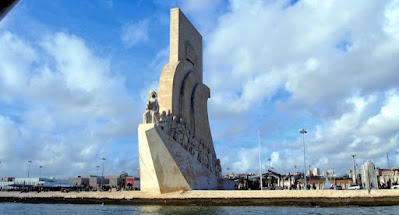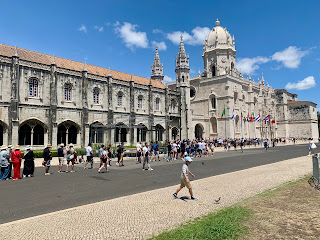15th Jul 2023
 |
| 'Monument of the Discoveries' in Bélem |
Left: The Presidential Palace is on the eastern end of town. I happened to pass as they were 'changing the guard' which was done with exemplary 'drill' and panache.
Right: A sentry in his box. Very smart, although I'm not so sure about his 'shades' and scruffy facial hair.
Left: A vast and elaborate piece of architecture, this is a monastery, the 'Mosteiro dos Jerónimas' which takes up an entire block. It features highly in the guide books as a 'National Pantheon'; whatever that means. There was a 200yd queue to get in. I wasn't prepared to wait that long, so what is inside is a mystery to me. A monks' striptease show? A shopping 'mall'? I doubt it. Look it up.
The history of Portuguese maritime exploration, trade and colonisation is extraordinary. It far pre-dates anything us Brits did, or any other nation for that matter. Despite the likes of our Francis Drake, James Cook and Ernest Shackleton etc., the Portuguese feature, by far, the greatest maritime explorers dating from the early 15th century. Just Google 'list of maritime explorers' and be amazed!
Left: Starting in the early 1400s, with such dodgy looking vessels as these, the likes of Prince Henry the Navigator, Vasco da Gama, Ferdinand Magellan and lots more. established the most impressive world-wide routes. Even the Italian navigator Christopher Columbus was trained by the Portuguese.
Right: By the 16th century the Portuguese had established these routes (and colonies). 'Click on' to enlarge. It is quite amazing. They were also the front-runners in inventing maritime navigational instruments.
Left: A statue of Vasco da Gama. The museum contained models of all the significant ships throughout the ages. I won't bore you with many subsequent photos. There were hundreds.
After a long tour through the ages and , as said, hundreds of displays, it ends with a modern Portuguese frigate housing a Lynx helicopter, with which I am somewhat familiar.
The Planetarium was a separate exhibition which had complex 3D cinematic displays of various happenings in space. I didn't have time.
Right: These rusty bits of metal were, the blurb told us, the anchors recently recovered (in 2014?) from Christopher Columbus' ship, the Santa Maria, which sank off Haiti in 1492. Who knows!
The museum had a separate hall exhibiting 'barges' and early seaplanes. Left: The Portuguese Royal Barge built in 1778 for Queen Maria. Apparently it was still afloat more recently because our Queen Elizabeth 2 was given a ride in it. It was propelled by 80 oarsmen (and perhaps an outboard motor?)
Right: Various early seaplanes from the Portuguese Navy. I failed to make a note of what they are.
I was in this museum for over two hours. I am no nautical buff or enthusiast, but found it fascinating and so well displayed. Left: Just for the benefit of my 'scrutiniser' at OMPITA, I attach this portrait of a famous Portuguese admiral. I was interested at the time but failed to make a note of who he was (WW1 era?). A reward of Pie 'n Mash if the answer is forthcoming.
Right: The ubiquitous 'tuk-tuks' providing transport around town. There were also 'horses and carriages' which clip-clopped along the streets carrying, probably wealthy, tourists. I walked.
Left: The Torre de Bélem. A fortified and armed tower (Unesco Heritage site) on the western entry to the port which protected the place from nasty hostile incomers. Built in the 15th century and of very extravagant design. It has 4 storeys open to the public.
The lower level houses a battery of guns with a 180º coverage of the approach to the harbour area. I'm not sure if these guns were ever used in anger.
One had to queue (there were big groups of tourists) to get from one floor to the next to let those above come down before the next group could go up or vice-versa. It took ages and, frankly, the views from the floors were all similar. The floors were all splendidly built with much decorative 'regal' architecture and all served some purpose or other. The top one was a chapel. The builders in those days, when you could get them of course, were impressive.
Right: A view east down the harbour front. As I came to discover this river front (on the Tagus) all the way down past Lisbon is, and always was, host to thousands of boats of various size and shape. Not so many galleons nowadays.
 Left: A seaplane mounted near the Tower from, I believe, just after WW1. It was put there to celebrate the 100th anniversary of Portuguese Naval aviation, I think. There is a 'dummy' pilot in the cockpit.
Left: A seaplane mounted near the Tower from, I believe, just after WW1. It was put there to celebrate the 100th anniversary of Portuguese Naval aviation, I think. There is a 'dummy' pilot in the cockpit.
Right: The Monument to the Discoveries, built to celebrate all the extraordinary navigators and explorers who carved out the extensive Portuguese trade routes and subsequent colonies worldwide from 500 years ago. It had a lift to the top which, of course, I took and it afforded some good views. There is a museum in the basement to show the old dictator António Salazar's (in power 1932 - 1968) efforts on the world exhibition stage to equal his other contemporary 'dictators', ie. Franco, Mussolini, Hitler etc. Mr Salazar has rather 'mixed' revues! I'm not sure what that 'museum' was meant to prove.
I often use a 'Lonely Planet' guide book to give me a 'heads up' in these places. They are normally very objective and useful. One thing that rather pissed me off is that the Portuguese version used four pages to disparage Portuguese 'colonial history' and their use of slaves, presumably written by a woke 'lefty' contributor. This business of condemning past empires of colonialism and slavery seems to be popular nowadays. I think it is misguided and pointless. All previous successful and powerful nations back in the olden days (ie. over 200 years ago) had colonies and used slaves; Romans, Greeks, Persians (now Iran), Austro-Hungarians, even the Muslim Moors who colonised tracts of Spain and Italy (and Portugal). It was considered acceptable, indeed normal, at the time. OK, not now of course, but the British with their Empire and, indeed, the Portuguese come in for more flack than most from the Lefties. What are they now supposed to do about things that happened hundreds of years ago? Put themselves in jail? Self flagellate? Disband? The critics don't seem to go for the Romans, Greeks, Persians (Iran) Austrians etc. nor even slavery currently existing in some nations of the world, in quite the same way! I believe some Empires, including the British one, did more good than harm and we should be proud of it. Yes, some terrible and brutal things were done (it was a more brutal world then), and national profit and power was gained from it, but I remember touring India where so many Indians (and Pakistanis) are actually grateful for much of the infrastructure, legal systems, buildings, technology, military know-how and traditions which we left (and cricket of course). The same could be said of Africa, and many other countries previously colonised by more technically advanced nations. After all, the Romans taught us Brits a few good lessons (see Monty Python..."what did the Romans ever do for us...apart from the laws, the aquaducts, the roads etc. etc. sketch). Maybe there is a 'cut-off' date to criticise. Anyway, this is a contentious subject I suppose, and certainly not what one wants to read about in the Lonely Planet guide book!
Left: A view of the splendid mosaic forecourt beneath the monument. Someone spent a lot of time and effort making this!
Left: A tall monument in the splendid park. A statue to Prince Alphonse el Grande Pouffe? Before launch? Haven't a clue!
There was so much to see in Bélem; more museums than you can shake a stick at and I only scratched the surface.
Having embarked on this trip around Portugal I am becoming overwhelmed by things to see and talk about. I find it a fascinating country which is more than you may think of my wafflings.























No comments:
Post a Comment